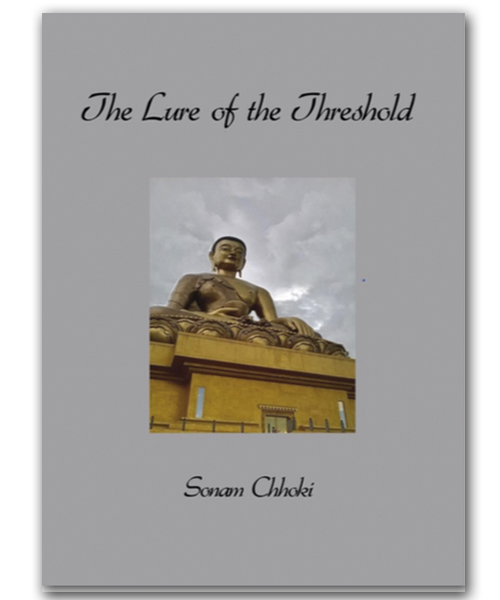
Book Review: The Lure of the Theshold
By Sonam Chhoki
Published by Editions des petits nuages
Ottawa, Canada
2021
unpaginated
ISBN: 978-1-926519-58-6
Available in a Kindle edition from Amazon
Free PDF available from the author
Review by Bob Lucky

There are thresholds, and then there are thresholds. Moreover, one person’s threshold may be another person’s obstacle. Sonam Chhoki’s The Lure of the Threshold explores a variety of thresholds, including the veil of maya, beyond which (as explained in the introduction) “lies an Awakening, a path empty of illusion.” Of course, until we cross that bridge, if we ever get there, we muddle through a world of appearances or illusions, the world of samsara, cycles of death and rebirth. Getting from one side to the other means crossing the threshold known as bardo. Some readers of this opening paragraph may, at this point, feel disinclined to pick up this chapbook, but I assure you, Chhoki is deft at making the strange familiar and occasionally the familiar strange.
As Glenn G. Coats’s afterword illustrates, readers of world literature, including haibun, often have to deal in some way with the unfamiliar. They encounter unknown cultural references (historical, political, mythological, theological, artistic, etc.) and varieties of English that differ in everything as minor as spelling to more complex aesthetic issues — one writer’s norm may be another writer’s abomination. It’s a process that obscures some thresholds and creates others that compound the obstacles to understanding. Coats sees the value of not getting hung up about not understanding a text, but rather enjoying it for what it does offer. Part of what a text offers depends on what the reader brings to it, of course. Coats admits to not understanding the Buddhist symbolism in Chhoki’s haibun, but he can and does appreciate her imagery and the way she uses words to weave mystery and magic. As Norwegian writer Tarjei Vesaas has noted, “Anyone who absolutely has to understand everything he sees misses a lot.”1
In her introduction, Chhoki explains that she’s drawn to haibun’s immersive narrative, and its potential in “exploring the hinterland of the margins of consciousness, where the strange and the familiar elide.” This is close to surrealism, or perhaps magical realism. But the hinterland that Chhoki explores is familiar to all of us on some level. Even though we may not have had oracles in our childhood, and a rabbi’s or a priest’s or an imam’s “message” might be different, readers can relate to this scene:
Looking for words
The old oracle, whose healing songs soothed my childhood fevers, is ill. It is a humid
July evening as I make my way to her hut. I have found an old photo of her talking to the King. I feel she might like the memento.
She runs a finger over the pale images and smiles. She opens, closes her palms. Mosquitoes whine in her dark room.
She straightens the folds of her yak wool blanket and says, ‘There’s nothing.’ I make her some tea. She dips the photo into the steaming wooden bowl and stirs.
cave temple—
eyes of Meditating Buddha
in lightning flashes
Likewise, it’s no stretch to appreciate the imagery and oneiric surrealism of “No signposts in dreams”:
A piano sits in a field dotted with aged eucalyptus trees. Someone has left the lid open as if they might return for an impromptu. Cold whisper of wind. With their white breaths streaming like some strange ciphers two young women step out from the shadows. A wooden, painted man accompanies them marching to their footfall. With a flourish he runs his fingers on the ivory keys. At first a tinkle, each note grows to implode with unruly joy. The women fling their heads back, link arms and dance. They reel in heady spins and disappear at the first rays of light.
solstice sun—
pillars of clouds topple
into the peaks
Nor is one likely to miss the irony and humor in “Higher Rebirth” (which features a dozing monk, his mouth half open, and a wandering blue bottle fly) or the fable-like quality of “Fool Moon” (about a young cobra who ignores his father’s warnings about “monsters that rumble” and ripples off onto the highway). The bardo, the liminal state between death and rebirth, isn’t difficult to conceptualize.
On the other hand, as Coats experienced, some of the symbolism escaped me. Cobras show up in a couple of haibun. Sometimes a snake is just a snake, but in Hinduism and Buddhism it is often a symbol of death and rebirth. And “The hunger for elsewhere” seems to me pregnant with symbolism that is reduced to mere imagery because I don’t know it. Fortunately, the imagery is memorable.
The hunger for elsewhere
Wandering the night in the mountains, a monk clad in gold rides out of the fog on a black mare. He holds out a hand; I climb behind him and see the hole in his back.
frozen waterfall
the lammergeier’s shrill whistle
echoing in the ravine
Colors are often symbolic. Gold? Black? And what is that hole in the monk’s back? The haiku, for better or worse, makes me think of a sky burial because I know a lammergeier is a vulture. This is where not knowing exactly what is going on can lead a reader astray, but for the most part, Chhoki is an excellent guide through her world.
The haibun that resonate with me most are those that let me glimpse into her cultural and spiritual world, and they comprise most of the haibun in the collection. The purely autobiographical haibun such as “Short history of love” and “Painting memories,” while well written, seem flat in comparison. The haiku are excellent throughout, and a couple not afraid of simile. This is a collection to add to your haibun library.
Since an aspect of this review is to acknowledge not-fully-understanding as an aesthetic experience, it is fitting that I end with this haibun.
Beware of Knowing
He is waiting in a yak-hide boat on the moon-glazed glacier lake.
‘How can we ride the ice?’ I ask.
‘Your insatiable need to make sense, to map the world and glean meaning from everything!’ He cries.
I hesitate at the frozen rim.
He loops a silver rope around Orion’s belt and sails out of the night.
harp of wind
blue pine branches rise
like butterfly wings
References
- Vesaas, Tarjei. Through Naked Branches: Selected Poems of Tarjei Vesaas. Roger Greenwald, translator. Princeton University Press, 2000.
About the Reviewer

Bob Lucky is the author most recently of My Thology: Not Always True But Always Truth (Cyberwit, 2019) and the chapbook Conversation Starters in a Language No One Speaks (SurVision Books, 2018), which was a winner of the James Tate Poetry Prize in 2018. Lucky lives in Portugal, where he is working his way through all the regional cheeses and wines.
